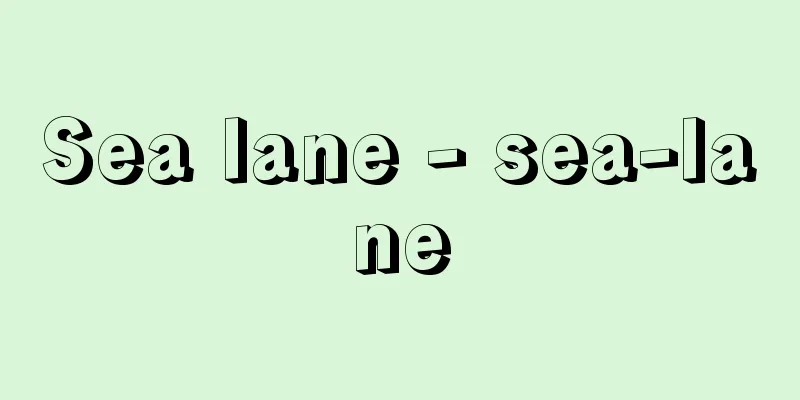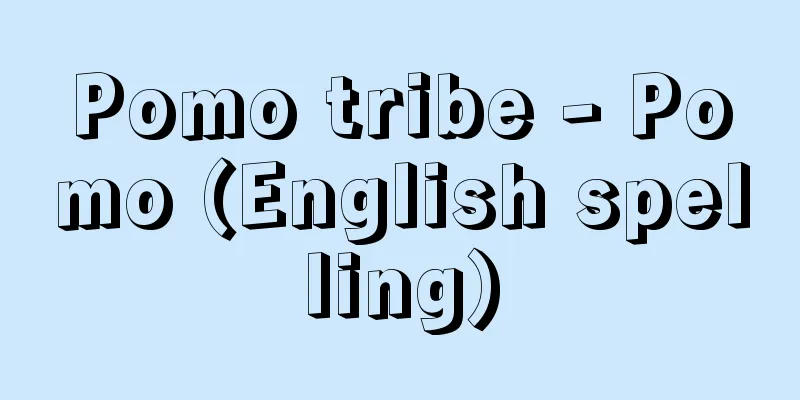Sea lane - sea-lane

|
It is usually translated as sea lane, sea route, or sea supply route. A. T. Mahan, the founder of sea power theory, considered the ocean to be a "vast public land" and "one great highway." Sea lanes are the maritime routes described there for various purposes in a broad sense. In Japan, it is used to mean maritime trade routes in general, but originally it was called SLOC (Sea Lines of Communication) in military terms, specifically referring to maritime lines of communication that connect operational forces at sea with bases for the logistics and communication necessary for the conduct of war. According to Mahan, control of SLOC is the source of sea power. During the Cold War, the US Navy determined that the Soviet fleet's maritime advance was due to the US's attempt to cut off SLOCs, and cooperated with Western navies to counter it. In Japan, it was incorporated into one of the joint operational plans based on the "Guidelines for Japan-US Defense Cooperation" (commonly known as the Japan-US Guidelines) decided in 1978 (Showa 53), and this was called sea lane defense. Prime Minister Suzuki Zenko stated during his visit to the United States in 1981 that "We will protect sea lanes within a range of approximately 1,000 nautical miles as a constitutional self-defense range," and since then, the term "1,000 nautical mile sea lane defense" has been established. The range is roughly north of the Philippines and west of Guam. The reason why the military SLOC was transferred to the more vague term sea lane is that in Japan, the exercise of collective self-defense and overseas dispatch of troops are prohibited by the constitution, so a term that can be explained within the range of individual self-defense was required. The 1983 edition of the Defense of Japan White Paper explains that "sea lane defense is to ensure the safety of maritime traffic through the cumulative effect of a combination of various operations, such as wide-area patrols, ship escorts, and defense of ports and straits." As a result, a large number of large escort ships and P-3C anti-submarine patrol aircraft were introduced. [Tetsuo Maeda] “Dictionary of National Defense Terms” edited by the National Defense Academy (1980, Asagumo Shimbun) [References] | |Source: Shogakukan Encyclopedia Nipponica About Encyclopedia Nipponica Information | Legend |
|
通常、航路帯もしくは海上交通路、海上補給路と訳される。シーパワー論の創始者A・T・マハンは海洋を「広大な公有地」「一大公路」とみなした。そこに記されたさまざまな目的に基づく海上の道が広義のシーレーンである。日本では海上交易路一般の意味に用いられるが、もともとは軍事用語としてSLOC(Sea Lines of Communication)と限定的によばれ、洋上の作戦部隊と根拠地を結ぶ戦争遂行に必要な兵站(へいたん)・連絡のための海上交通線をさす。マハンによればSLOCの支配こそシーパワーの源泉だとされる。冷戦期の米海軍は、ソ連艦隊の海洋進出がアメリカのSLOC遮断にあると判断し、西側海軍と協力して対抗した。日本では、1978年(昭和53)に決定された「日米防衛協力のための指針」(通称日米ガイドライン)に基づく共同作戦計画の一つに組み入れられ、これをシーレーン防衛とよんだ。鈴木善幸首相は81年の訪米時、「シーレーンについては約1000海里を憲法上の自衛の範囲として守っていく」と述べ、以後、「シーレーン1000海里防衛」の名で定着することになった。その範囲はおおむねフィリピン以北、グアム以西とされる。軍事目的のSLOCが、より漠然としたシーレーンに移し替えられた理由は、日本の場合、集団的自衛権の行使や海外派兵が憲法上禁じられているため、個別的自衛権の範囲内で説明可能な用語が求められたと考えられる。『防衛白書』1983年版は「シーレーン防衛とは広域哨戒(しょうかい)、船舶の護衛、港湾・海峡の防備など、各種の作戦の組み合わせによる累積効果によって、海上交通の安全を確保すること」と解説している。この結果、大型護衛艦とP‐3C対潜哨戒機が多数導入されることになった。 [前田哲男] 『防衛学会編『国防用語辞典』(1980・朝雲新聞社)』 [参照項目] | |出典 小学館 日本大百科全書(ニッポニカ)日本大百科全書(ニッポニカ)について 情報 | 凡例 |
Recommend
Taikoubou
It refers to a fisherman or a talented person who ...
Philostratos - Philostratos (English spelling)
Four writers of the same name from the Neo-Sophis...
Aid Conditions Relaxation Index
…When developed countries provide aid to developi...
Catecholamines
…A tumor arising from the chromaffin cells of the...
Collared turtle dove - Collared turtle dove
A bird of the family Columbiformes (illustration)....
Unohana
Okara. ◇It is said that this name was given becaus...
Kaku Saiyu
He was a commander of the anti-Japanese volunteer...
Ruff (English spelling)
A unique ruffled collar worn by both men and women...
Schiele - Egon Schiele
Austrian painter and draftsman. Born in Tulln on ...
Tsuguyama Kengyo
?-1697 A koto musician from the early Edo period....
Hibakari - Hibakari
A snake of the order Squamata, family Colubridae,...
"Amateur Movies" - Amachuamubies
...This kind of experimental film movement seemed...
Futaobikoyaga (English spelling) Green rice caterpillar
A moth belonging to the order Lepidoptera and the...
Endorsement - Hashiuragaki
A term used in paleography. The right edge of a do...
hinderedsettling
…When a mixture of cohesive particles or particle...









